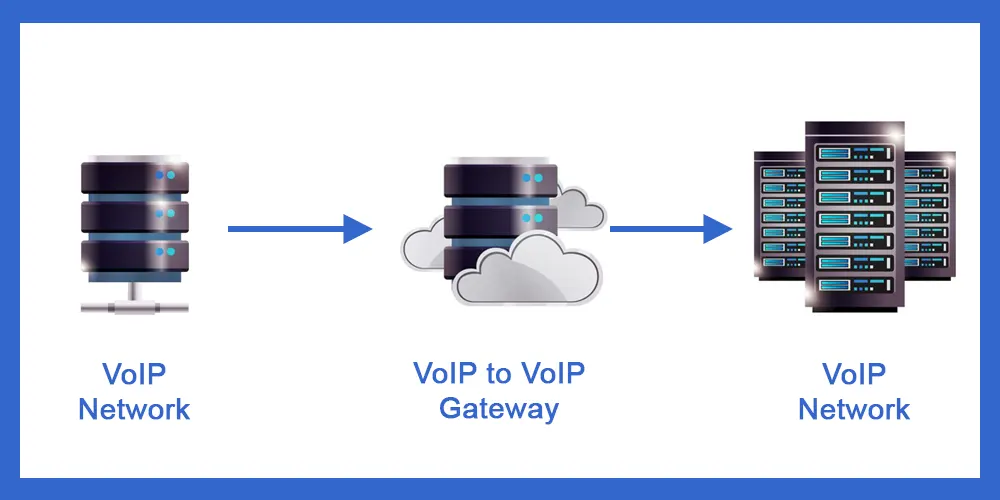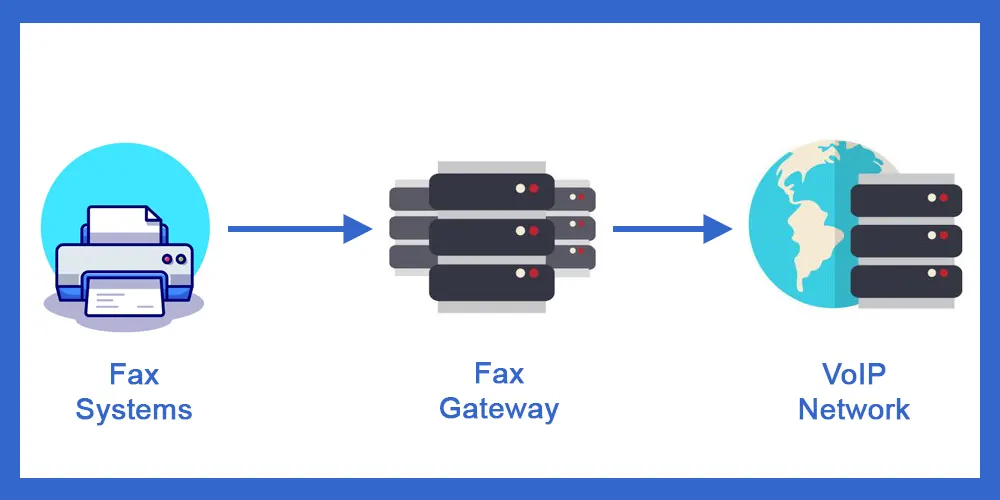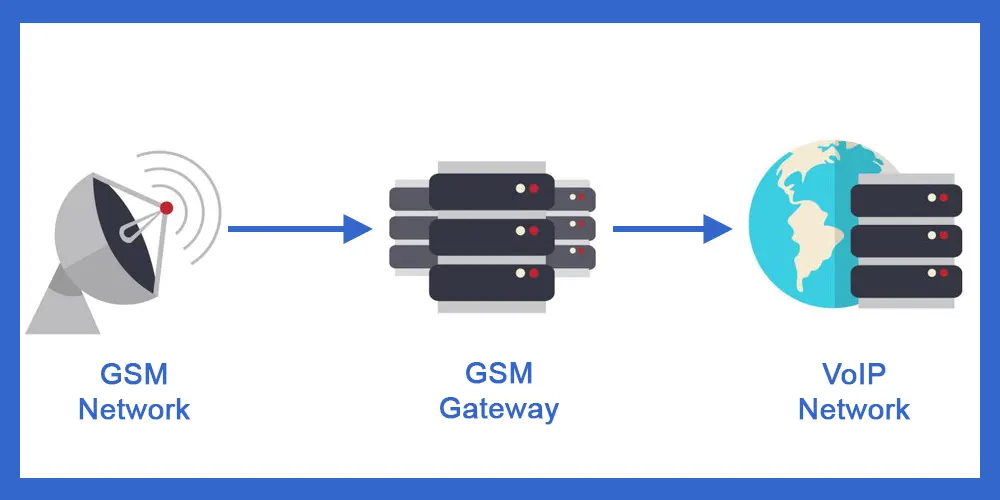5 Unique Types of VoIP Gateways Explained!
In our earlier blog, we took a deep dive into the 5 important types of VoIP Gateways. During the research for that blog, I came across some unique VoIP Gateways that I had no idea existed.
So I did what I do best. I doubled down on the research and put together this blog. The aim? To teach you all about the unique systems and solutions that you might be searching for but never knew existed.
Two gateways among the 5 unique ones we’ll be covering left me astonished. Turns out two technologies I thought were obsolete are still relevant and one is even growing.
I hope that was enough to spark curiosity within you. Now let’s wrap up this introduction and dive straight into a journey of discovery!
VoIP-to-VoIP Gateways

Facilitating VoIP Network Connectivity
VoIP-to-VoIP gateways are essential components in VoIP networks, designed to enable communication between different VoIP networks or service providers.
These gateways offer unique features and functions that facilitate interoperability between various VoIP protocols and systems. Let's explore what VoIP-to-VoIP gateways are and detail five of their distinctive features and functions:
Features and Functions of VoIP-to-VoIP Gateways
1. Protocol Conversion
VoIP-to-VoIP gateways excel at protocol conversion. They translate VoIP signaling and control protocols between different VoIP networks.
Thus allowing communication between systems that use distinct VoIP protocols, such as SIP, H.323, or proprietary standards.
2. Interconnection Between VoIP Networks
These gateways serve as the bridge between separate VoIP networks or service providers. This enables calls and multimedia communication to flow smoothly across different domains. They facilitate peering agreements and interconnections.
3. Security and Encryption
VoIP-to-VoIP gateways often incorporate security measures like encryption and firewall capabilities to protect voice traffic from potential security threats. This enhances the overall security of VoIP communication.
4. Routing and Load Balancing
These gateways handle call routing and load balancing, ensuring efficient distribution of voice traffic between various VoIP networks. They help prevent network congestion and ensure reliable call delivery.
5. Quality of Service (QoS) Management
VoIP-to-VoIP gateways monitor and manage the Quality of Service (QoS) for voice traffic. They prioritize voice packets to minimize latency and packet loss, ensuring that voice quality is maintained at a high standard during communication.
These unique features and functions distinguish VoIP-to-VoIP gateways as specialized devices that excel as bridges between different VoIP Networks.
Ear & Mouth (E&M) Gateways

Integrating Legacy E&M Signaling

Ear and Mouth (E&M) VoIP gateways are specialized devices that play a crucial role in scenarios that require the handling of E&M signaling. E&M is a legacy telecommunications interface.
These gateways facilitate the integration of equipment using E&M signaling with modern VoIP networks. Let's explore what E&M VoIP gateways are and detail five of their unique features and functions:
Features and Functions of E&M VoIP Gateways
1. E&M Signal Conversion
The primary function of E&M VoIP gateways is to convert E&M signaling into a format compatible with VoIP networks. They allow legacy equipment that uses E&M signaling to connect with modern VoIP systems.
2. Interfacing with Legacy Systems
These gateways serve as a bridge between legacy telephony equipment and VoIP networks. They allow legacy devices such as analog telephones, paging systems, or intercoms to operate within VoIP environments.
3. Channelized Communication
E&M VoIP gateways often support channelized communication, handling multiple channels simultaneously. This is essential for scenarios where several channels need to be managed, such as in industrial settings or legacy intercom systems.
4. Protocol Conversion
E&M VoIP gateways often provide protocol conversion, allowing them to interface with various VoIP protocols, such as SIP or H.323. This ensures compatibility with different VoIP systems.
5. Enhanced Voice Quality
Many E&M VoIP gateways offer QoS features to optimize voice quality. They prioritize voice packets and minimize latency to ensure clear and reliable voice communication.
Thus, E&M Gateways helps deliver all the advantages of VoIP to legacy telecommunication systems. These gateways are especially important as they can modernize a country’s communication infrastructure without requiring major reworks.
ISDN PRI/BRI Gateways

Bridging ISDN and VoIP Communication
ISDN PRI/BRI VoIP gateways are specialized devices designed to enable the seamless integration of Integrated Services Digital Network connections with VoIP networks. This includes both Primary Rate Interface (PRI) and Basic Rate Interface (BRI).
These gateways offer a range of unique features and functions that are essential for bridging traditional ISDN communication with modern VoIP systems.
Features and Functions of ISDN PRI/BRI VoIP Gateways
1. ISDN Interface Support
ISDN PRI/BRI VoIP gateways are equipped with interface ports that are compatible with ISDN connections. This includes both PRI, used for larger organizations, and BRI, designed for smaller businesses and homes.
2. Protocol Conversion
These gateways specialize in protocol conversion, translating the ISDN signaling and control protocols to VoIP-compatible protocols like SIP or H.323. This ensures smooth communication between ISDN and VoIP networks.
3. Channelized Communication
ISDN PRI/BRI VoIP gateways often support channelized communication. Thus allowing the management of multiple ISDN channels simultaneously. This is especially useful in scenarios where several channels are needed, such as in call centers.
4. QoS Management
Many of these gateways offer QoS management features. They prioritize voice traffic to minimize latency and packet loss, ensuring that voice quality remains high during communication.
5. Fallback and Redundancy
ISDN PRI/BRI VoIP gateways often include fallback and redundancy mechanisms. In case of VoIP network issues, they can automatically switch to ISDN as a backup, ensuring continuity of voice communication.
Thus, in another example, these gateways enable us to deliver the benefits of VoIP over traditional and legacy telecommunication systems.
Fax Gateways

Facilitating Fax Communication in VoIP Networks
Fax VoIP gateways are specialized devices designed to enable the transmission of fax documents over VoIP networks. These gateways offer a range of unique features and functions tailored for the efficient and reliable handling of fax communication.
But wait, didn’t emails render Faxes obsolete? Turns out not. In fact, the FAX market is projected to grow at a CAGR of 11%. Industries such as Healthcare, manufacturing, legal and government still widely use Fax for communication.
Features and Functions of Fax VoIP Gateways
1. T.38 Fax Protocol Support
Fax VoIP gateways support the T.38 fax protocol, specifically designed for fax transmission over IP networks. This ensures the compatibility of the gateway with fax devices and networks.
2. Fax Over IP (FoIP) Conversion
These gateways perform analog-to-digital conversion for fax signals, ensuring that fax documents are efficiently transmitted as digital data packets over VoIP networks.
3. Reliable Fax Relay
Error Correction and Retransmission - Fax VoIP gateways offer reliable fax relay mechanisms. They employ error correction and retransmission techniques to minimize the chance of fax transmission errors and ensure successful document delivery.
4. Integration with Traditional Fax Machines
These gateways allow the integration of traditional analog fax machines and multifunction printers with VoIP networks. This is vital for businesses that still rely on fax communication.
5. Compatibility with VoIP Infrastructure
Fax VoIP gateways are designed to seamlessly integrate with VoIP infrastructure. They ensure that fax communication is a natural part of VoIP networks, allowing for efficient routing and handling of fax traffic.
Before I wrote this blog, I had no idea that Faxes were still relevant and being used. It came as a surprise to know that Faxes are registering a growth in usage and working in tandem with VoIP to deliver a comprehensive communication experience.
GSM Gateways

Bridging Cellular and VoIP Communication
GSM VoIP gateways are specialized devices that facilitate the integration of cellular networks, particularly GSM, with VoIP networks.
These gateways offer a range of unique features and functions designed to enable communication between mobile networks and VoIP systems. Let's explore what GSM VoIP gateways are and detail five of their distinctive features and functions:
Features and Functions of GSM VoIP Gateways
1. Cellular Network Interface
GSM VoIP gateways are equipped with cellular network interfaces, allowing them to connect to GSM networks. This is essential for mobile communication integration.
2. SIP Protocol Support
These gateways support the SIP (Session Initiation Protocol), a common VoIP protocol. This ensures seamless communication between GSM networks and VoIP systems.
3. GSM-to-VoIP Conversion
GSM VoIP gateways perform the conversion of analog GSM signals into digital data packets suitable for transmission over VoIP networks.
4. Mobile-to-VoIP Communication
These gateways allow mobile devices, such as cell phones or smartphones, to communicate with VoIP endpoints and networks. This is useful for reducing international calling costs or connecting remote mobile users.
5. SIM Card Management
GSM VoIP gateways often have features for managing SIM cards. They can route calls and messages through specific SIM cards, providing flexibility and cost control in mobile communication.
Thus, in our final example today, GSM Gateways act as bridges between VoIP and GSM Networks. This integration is valuable for businesses and service providers looking to combine the reach of mobile networks with the cost-efficiency of VoIP communication.
Ending With
The world of telecommunication always has hidden aces up its sleeves. Who knew there were so many types of unique Gateways besides the most common ones? I certainly didn’t before I wrote this blog!
The good thing is that having this much variety and specialty means we can create a more connected world.
The gateways covered in this blog offer a unique and valued utility. These allow us to benefit from the cost-effectiveness and convenience of VoIP while not having to completely replace legacy telecommunication infrastructure.
Thus, with these gateways, you’re able to keep the costs down in a multitude of ways!
























































































































